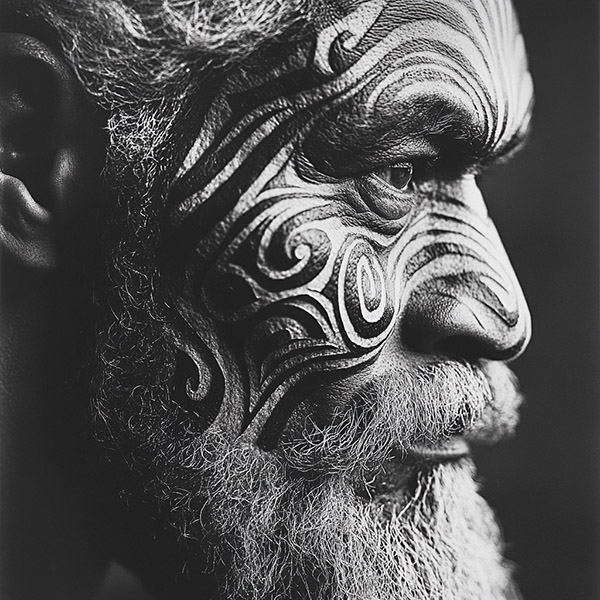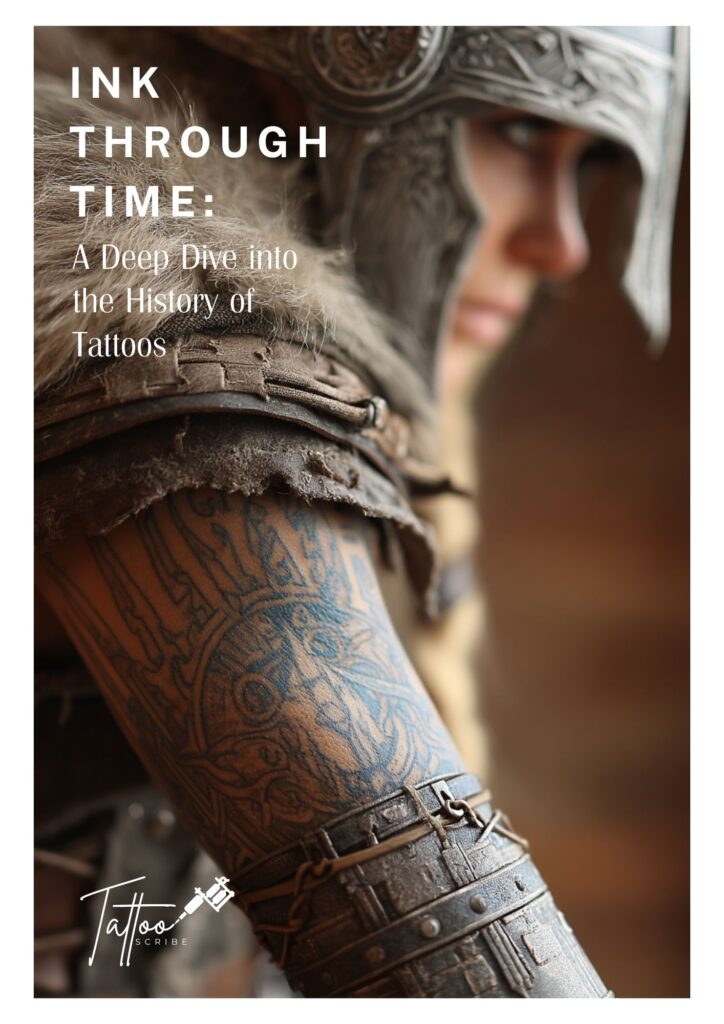Download A Deep Dive With “Ink Through Time”
Tattoos have been around for millennia, etching stories into human skin long before modern parlors and electric needles existed. If you’ve ever wondered about the history of tattoos across cultures or how this ancient art evolved into today’s vibrant designs, our new eBook, Ink Through Time: A Deep Dive into the History of Tattoos, is your ticket to an incredible journey.
Available for free on tattooscribe.com, this eBook uncovers the origins, cultural significance, and modern renaissance of tattooing—a must-read for enthusiasts and curious minds alike. Let’s break down what you’ll discover inside and why the evolution of tattooing practices still fascinates us today.
Tattoos in Ancient Times: Where It All Began

The story of tattoos starts over 5,000 years ago, and Ink Through Time kicks off with the earliest evidence of this practice. One standout is Ötzi the Iceman, a 3300 BCE mummy found in the Alps with 61 simple tattoos—lines and crosses likely used for healing.
The eBook digs into how ancient tattooing techniques, like rubbing charcoal into cuts with bone needles, weren’t just decorative but practical too. Imagine a world where ink doubled as medicine!
From there, we travel to places like Egypt and Polynesia. In Egypt around 2000 BCE, women like the priestess Amunet wore tattoos tied to rituals and status—dots and dashes that hinted at fertility or divine protection. Meanwhile, Polynesia gave us the word “tattoo” from tatau, where bone combs and candlenut soot created patterns symbolizing courage and lineage.
This chapter offers a deep dive into ancient tattoo history, showing how these early marks laid the foundation for everything that followed.
Tattoos Across Civilizations: Symbols of Power and Spirit

As societies grew, so did tattooing’s role, and Ink Through Time explores this shift in vivid detail. In ancient Egypt, tattoos marked spiritual devotion, while in Polynesia, the Samoan pe’a—a full-body tattoo—became a rite of passage for men, etched with shark teeth over weeks of pain.
The eBook reveals how cultural significance of tattoos in Polynesia turned ink into a social contract, a tradition still echoed in modern tribal designs.
Japan’s early Ainu people tattooed their faces for spiritual protection, a practice that later morphed into something more rebellious. By contrast, Egypt’s tattooed mummies show a quieter reverence.
These stories highlight the historical tattoo practices by region, offering readers a global lens on how ink reflected identity, faith, and hierarchy thousands of years ago. It’s a fascinating look at how tattoos were never just skin-deep—they were woven into the fabric of life.
The Middle Ages to the Age of Sail: A Shifting Reputation

Fast forward to the Middle Ages, and tattoos took a hit in Europe thanks to religious taboos. Ink Through Time explains how Christianity’s influence pushed tattooing underground, though pilgrims still got crosses inked in Jerusalem as badges of faith. Meanwhile, Polynesia and Japan kept the art alive—Maori ta moko and Japanese tebori tattoos flourished as symbols of heritage and defiance.
Then came the Age of Sail in the 18th century, when sailors brought tattoos to the West. Captain Cook’s encounters with Polynesian tatau sparked a craze—anchors and swallows became emblems of survival. The eBook traces this history of tattoos in Western culture, from back-alley parlors to a slow climb toward acceptance. It’s a turning point that shows how ink crossed oceans and reshaped perceptions.
Exploring the Wild History of Tattoos: From Ancient Ink to Modern Art

Tattoos are like time travelers etched into skin—thousands of years old, yet still kicking today. Ever wondered where they started or how they went from bone needles to buzzing machines?
The story’s wild, and our free eBook, Ink Through Time: A Deep Dive into the History of Tattoos, available at tattooscribe.com, unpacks it all. Let’s take a spin through the ages, from ancient healers to sailor swagger, and see why this art keeps us hooked.
Ancient Ink: Where It All Kicked Off

Tattoos go way back—over 5,000 years, to be exact. Picture Ötzi the Iceman, a guy from 3300 BCE found frozen in the Alps, rocking 61 tattoos. Just lines and crosses, sure, but they weren’t random—experts think they were for healing, like ancient acupuncture.
Ink Through Time dives into how they did it: rubbing charcoal into cuts with bone needles. No parlors, no numbing cream—just grit and ink. I tried a stick-and-poke once—ouch, but it felt primal.
Then there’s Egypt around 2000 BCE—women like Amunet, a priestess, had dots and dashes hinting at fertility or divine vibes. Polynesia, though? That’s where “tattoo” was born—tatau, with bone combs and soot marking courage and family ties. These weren’t just pretty—they were purpose, and the eBook lays out how those roots still echo in today’s ink.
Across Cultures: Power, Spirit, and Skin
Tattoos grew up with humanity, shifting from survival tools to symbols of soul. In Polynesia, the Samoan pe’a—a brutal full-body tattoo—meant manhood, carved with shark teeth over weeks. Ink Through Time gets into how that cultural weight made tattoos a badge of honor—think modern tribal ink’s DNA.
Japan’s Ainu tattooed their faces for spirit protection, while Egypt’s mummies wore quieter marks of faith. It’s crazy how ink could mean devotion one place, defiance another—I’ve seen a guy with a Polynesian sleeve who swears it’s his family tree.
Every culture added its flavor—status, rites, rebellion. The eBook maps this out, showing how tattoos were never just decoration; they were life stitched into skin.
Middle Ages to Sailors: Ink’s Rollercoaster
Europe’s Middle Ages weren’t tattoo-friendly—Christianity called it taboo, shoving it underground. But pilgrims snuck crosses from Jerusalem, little faith flags. Meanwhile, Polynesia and Japan kept the flame alive—Maori ta moko carved faces with chisels, Japanese tebori built myths into flesh.
Then the 1700s hit, and sailors flipped the script. Captain Cook met Polynesian tatau, and boom—anchors and swallows sailed West. Ink Through Time tracks how those salty designs—survival marks for sea dogs—started tattooing’s big comeback. My grand-dad had an anchor from his Navy days; said it kept him steady.
It’s a pivot point—tattoos went from outcast to obsession, crossing oceans and cracking open parlors. The eBook’s got the full scoop on how ink rode the waves.
Modern Ink: Rebellion to Renaissance
The 20th century lit the fuse—Samuel O’Reilly’s 1891 electric tattoo machine made it quick and sharp. Sailor Jerry mixed American bold with Japanese flair, and by the ‘60s, bikers and punks turned ink into a middle finger to the norm. Today? It’s a full-on renaissance—watercolor splashes, realism that pops, dotwork that mesmerizes. Ink Through Time ties it back—those ancient lines in Ötzi’s skin? They’re cousins to the Instagram tattoos blowing up now.
TV shows and social media fuel it—artists are rock stars, and styles are endless. I got a dotwork cat last year; feels ancient and fresh at once. The eBook nails how this boom still vibes with history—it’s not new, just louder.
Why This History Still Hooks Us
Tattoos stick around because they’re us—our scars, our wins, our tribes. From Ötzi’s healing marks to a sailor’s swallow, they’ve always told stories. Ink Through Time—free at tattooscribe.com—packs over 5,000 words of this saga, perfect for newbies or ink nerds. It’s got the dirt on ancient techniques, the cultural juice, the modern glow-up. Why care? Because every tattoo you see—or get—carries that legacy. My cat tattoo’s a nod to Polynesian precision, even if I didn’t know it then.
Keeping Your Ink Alive
Got a piece? Keep it sharp—wash it gentle, slap on lotion (coconut oil’s my pick), and dodge the sun. History’s tough; fading isn’t. The eBook’s got tips to make your ink last like the ancients wished theirs would.
Conclusion
Tattoos are a thread through time—Ötzi’s lines, Polynesian tatau, sailor anchors, today’s art explosion. Ink Through Time: A Deep Dive into the History of Tattoos pulls it all together, free on tattooscribe.com, and it’s a ride worth taking. It’s not just history; it’s why that ink on your arm—or the one you’re dreaming of—means something. From ancient healers to modern rebels, tattoos keep talking. Grab the eBook, dig in, and maybe find the story your skin’s itching to tell.


